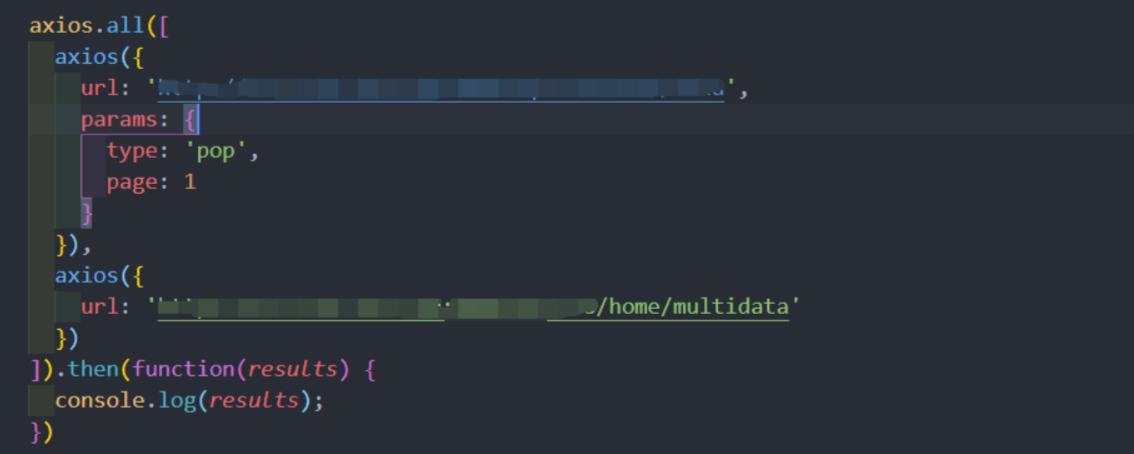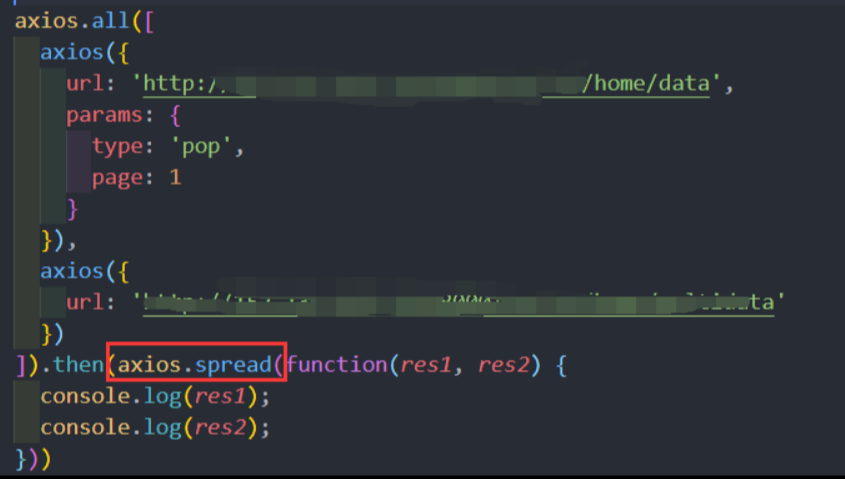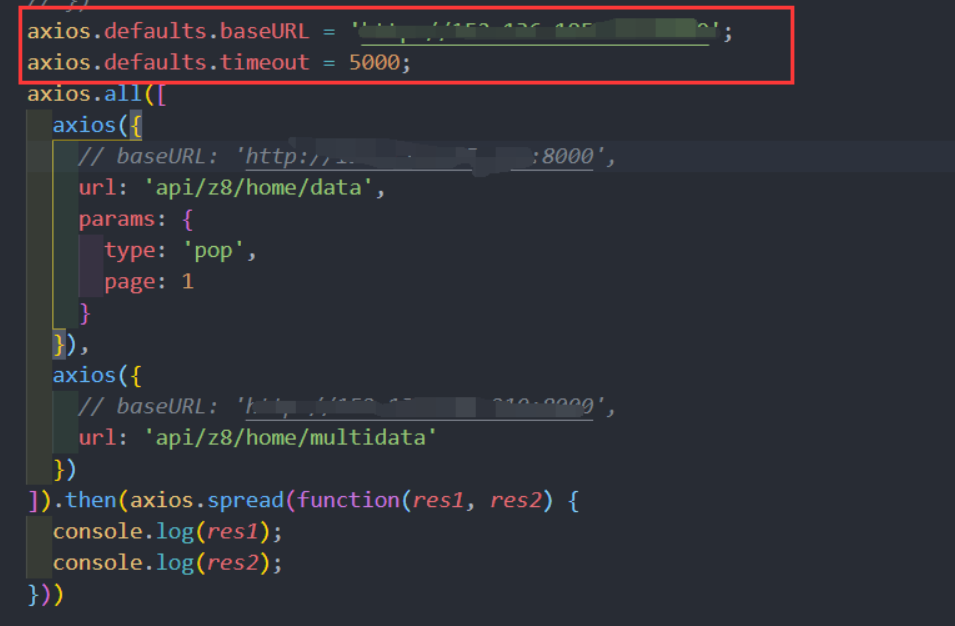Axios
前期解释
其实读取的方法是由两个: ajax以及axios
但是犹豫ajax对于dom操作过于频繁,Vue作者并不建议
另外有一个叫做早期的 vue-resource,但是2.0之后没有维护了,所以建议就只看axios
基本理解图
安装方式
Vue.js 2.0 版本推荐使用 axios 来完成 ajax 请求。
Axios 是一个基于 Promise 的 HTTP 库,可以用在浏览器和 node.js 中。
Github开源地址: https://github.com/axios/axios
使用 cdn:
<script src="https://unpkg.com/axios/dist/axios.min.js"></script>或
<script src="https://cdn.staticfile.org/axios/0.18.0/axios.min.js"></script>使用 npm:
$ npm install axios使用 bower:
$ bower install axios使用 yarn:
$ yarn add axios使用axios插件
import axios from "axios"通过axios实现数据请求
GET 方法
我们可以简单的读取 JSON 数据
<div id="app">
{{ info }}
</div>
<script type = "text/javascript">
new Vue({
el: '#app',
data () {
return {
info: null
}
},
/*例子
axios.get('/user?ID=12345')
.get('https://www.runoob.com/try/ajax/json_demo.json')
*/
mounted () {//response.data读取数据
// 发送get请求
// 参数1: 必填,字符串,请求的数据接口的url地址,例如请求地址:http://www.baidu.com?id=200
// 参数2:可选,请求参数和请求头内容,json对象,要提供给数据接口的参数
axios.get('服务器的资源地址',{ // http://www.baidu.com
params:{
参数名:'参数值key' : 'value', // id: 200,
},
headers:{
选项名:'选项值', // 请求头
}
}).then(response=>{ // 请求成功以后的回调函数
console.log("请求成功");
console.log(response.data); // 获取服务端提供的数据
}).catch(error=>{ // 请求失败以后的回调函数
console.log("请求失败");
console.log(error.response); // 获取错误信息
});
}
})
</script>POST 方法
<div id="app">
{{ info }}
</div>
<script type = "text/javascript">
new Vue({
el: '#app',
data () {
return {
info: null
}
},
mounted () {
axios
.post('https://www.runoob.com/try/ajax/demo_axios_post.php')
.then(response => (this.info = response))
.catch(function (error) { // 请求失败处理
console.log(error);
});
}
})
</script>// 发送post请求,参数和使用和axios.get()类似。
// 参数1: 必填,字符串,请求的数据接口的url地址
// 参数2:必填,json对象,要提供给数据接口的参数,如果没有参数,则必须使用{}
// 参数3:可选,json对象,请求头信息
axios.put('服务器的资源地址',{
username: 'xiaoming',
password: '123456'
},{
headers:{
选项名:"选项值",
}
})
.then(response=>{ // 请求成功以后的回调函数
console.log(response);
})
.catch(error=>{ // 请求失败以后的回调函数
console.log(error);
});在vue使用的过程中,如果要初始化操作,把初始化操作的代码放在 mounted 中执行。
mounted阶段就是在vm对象已经把data数据实现到页面以后。一般页面初始化使用。
例如,用户访问页面加载成功以后,就要执行的ajax请求。
另一个就是created,这个阶段就是在 vue对象创建以后,把ajax请求后端数据的代码放进 created
利用Vue.prototype.$http = axios 以及 同异步 async/await
async anotherGet(){
const {data}= await this.$http.get(' http://www.liulongbin.top:3005/api/getprodlist')
console.log(data)
},
async anotherPost(){
const {data}= await this.$http.post(' http://www.liulongbin.top:3005/api/addproduct',{name:'aa'})
console.log(data)
}执行多个并发请求
function getUserAccount() {
return axios.get('/user/12345');
}
function getUserPermissions() {
return axios.get('/user/12345/permissions');
}
axios.all([getUserAccount(), getUserPermissions()])
.then(axios.spread(function (acct, perms) {
// 两个请求现在都执行完成
}));axios API
可以通过向 axios 传递相关配置来创建请求。
config是一个对象,它默认是采用 GET 请求的,当然如果想要使用POST请求,可以添加 method:“POST”
axios 它返回的是一个Promise对象,可以直接在后面使用then catch等方法。
实例
axios(config)
// 发送 POST 请求
axios({
method: 'post',
url: '/user/12345',
data: {
firstName: 'Fred',
lastName: 'Flintstone'
}
});
// GET 请求远程图片
axios({
method:'get',
url:'http://bit.ly/2mTM3nY',
responseType:'stream'
})
.then(function(response) {
response.data.pipe(fs.createWriteStream('ada_lovelace.jpg'))
});
axios(url[, config])
// 发送 GET 请求(默认的方法)
axios('/user/12345');请求方法的别名
为方便使用,官方为所有支持的请求方法提供了别名,可以直接使用别名来发起请求:
axios.request(config)
axios.get(url[, config])
axios.delete(url[, config])
axios.head(url[, config])
axios.post(url[, data[, config]])
axios.put(url[, data[, config]])
axios.patch(url[, data[, config]])注意:在使用别名方法时, url、method、data 这些属性都不必在配置中指定。
并发
处理并发请求的助手函数:
axios.all(iterable)
//格式:axios.all([axios(config),axios(config)])
axios.spread(callback)
//使用格式: axios.all([axios(config),axios(config)]).then(axios.spread())使用 axios.spread 可将数组 [res1,res2] 展开为 res1, res2

全局配置创建
可以使用自定义配置新建一个 axios 实例:
axios.create([config])
const instance = axios.create({
baseURL: 'https://some-domain.com/api/',
timeout: 1000,
headers: {'X-Custom-Header': 'foobar'}
});
实例方法
以下是可用的实例方法。指定的配置将与实例的配置合并:
axios#request(config)
axios#get(url[, config])
axios#delete(url[, config])
axios#head(url[, config])
axios#post(url[, data[, config]])
axios#put(url[, data[, config]])
axios#patch(url[, data[, config]])请求配置项
下面是创建请求时可用的配置选项,注意只有 url 是必需的。如果没有指定 method,请求将默认使用 get 方法。
{
// `url` 是用于请求的服务器 URL
url: "/user",
// `method` 是创建请求时使用的方法
method: "get", // 默认是 get
// `baseURL` 将自动加在 `url` 前面,除非 `url` 是一个绝对 URL。
// 它可以通过设置一个 `baseURL` 便于为 axios 实例的方法传递相对 URL
baseURL: "https://some-domain.com/api/",
// `transformRequest` 允许在向服务器发送前,修改请求数据
// 只能用在 "PUT", "POST" 和 "PATCH" 这几个请求方法
// 后面数组中的函数必须返回一个字符串,或 ArrayBuffer,或 Stream
transformRequest: [function (data) {
// 对 data 进行任意转换处理
return data;
}],
// `transformResponse` 在传递给 then/catch 前,允许修改响应数据
transformResponse: [function (data) {
// 对 data 进行任意转换处理
return data;
}],
// `headers` 是即将被发送的自定义请求头
headers: {"X-Requested-With": "XMLHttpRequest"},
// `params` 是即将与请求一起发送的 URL 参数
// 必须是一个无格式对象(plain object)或 URLSearchParams 对象
params: {
ID: 12345
},
// `paramsSerializer` 是一个负责 `params` 序列化的函数
// (e.g. https://www.npmjs.com/package/qs, http://api.jquery.com/jquery.param/)
paramsSerializer: function(params) {
return Qs.stringify(params, {arrayFormat: "brackets"})
},
// `data` 是作为请求主体被发送的数据
// 只适用于这些请求方法 "PUT", "POST", 和 "PATCH"
// 在没有设置 `transformRequest` 时,必须是以下类型之一:
// - string, plain object, ArrayBuffer, ArrayBufferView, URLSearchParams
// - 浏览器专属:FormData, File, Blob
// - Node 专属: Stream
data: {
firstName: "Fred"
},
// `timeout` 指定请求超时的毫秒数(0 表示无超时时间)
// 如果请求花费了超过 `timeout` 的时间,请求将被中断
timeout: 1000,
// `withCredentials` 表示跨域请求时是否需要使用凭证
withCredentials: false, // 默认的
// `adapter` 允许自定义处理请求,以使测试更轻松
// 返回一个 promise 并应用一个有效的响应 (查阅 [response docs](#response-api)).
adapter: function (config) {
/* ... */
},
// `auth` 表示应该使用 HTTP 基础验证,并提供凭据
// 这将设置一个 `Authorization` 头,覆写掉现有的任意使用 `headers` 设置的自定义 `Authorization`头
auth: {
username: "janedoe",
password: "s00pers3cret"
},
// `responseType` 表示服务器响应的数据类型,可以是 "arraybuffer", "blob", "document", "json", "text", "stream"
responseType: "json", // 默认的
// `xsrfCookieName` 是用作 xsrf token 的值的cookie的名称
xsrfCookieName: "XSRF-TOKEN", // default
// `xsrfHeaderName` 是承载 xsrf token 的值的 HTTP 头的名称
xsrfHeaderName: "X-XSRF-TOKEN", // 默认的
// `onUploadProgress` 允许为上传处理进度事件
onUploadProgress: function (progressEvent) {
// 对原生进度事件的处理
},
// `onDownloadProgress` 允许为下载处理进度事件
onDownloadProgress: function (progressEvent) {
// 对原生进度事件的处理
},
// `maxContentLength` 定义允许的响应内容的最大尺寸
maxContentLength: 2000,
// `validateStatus` 定义对于给定的HTTP 响应状态码是 resolve 或 reject promise 。如果 `validateStatus` 返回 `true` (或者设置为 `null` 或 `undefined`),promise 将被 resolve; 否则,promise 将被 rejecte
validateStatus: function (status) {
return status >= 200 && status < 300; // 默认的
},
// `maxRedirects` 定义在 node.js 中 follow 的最大重定向数目
// 如果设置为0,将不会 follow 任何重定向
maxRedirects: 5, // 默认的
// `httpAgent` 和 `httpsAgent` 分别在 node.js 中用于定义在执行 http 和 https 时使用的自定义代理。允许像这样配置选项:
// `keepAlive` 默认没有启用
httpAgent: new http.Agent({ keepAlive: true }),
httpsAgent: new https.Agent({ keepAlive: true }),
// "proxy" 定义代理服务器的主机名称和端口
// `auth` 表示 HTTP 基础验证应当用于连接代理,并提供凭据
// 这将会设置一个 `Proxy-Authorization` 头,覆写掉已有的通过使用 `header` 设置的自定义 `Proxy-Authorization` 头。
proxy: {
host: "127.0.0.1",
port: 9000,
auth: : {
username: "mikeymike",
password: "rapunz3l"
}
},
// `cancelToken` 指定用于取消请求的 cancel token
// (查看后面的 Cancellation 这节了解更多)
cancelToken: new CancelToken(function (cancel) {
})
}响应结构
axios请求的响应包含以下信息:
{
// `data` 由服务器提供的响应
data: {},
// `status` HTTP 状态码
status: 200,
// `statusText` 来自服务器响应的 HTTP 状态信息
statusText: "OK",
// `headers` 服务器响应的头
headers: {},
// `config` 是为请求提供的配置信息
config: {}
}使用 then 时,会接收下面这样的响应:
axios.get("/user/12345")
.then(function(response) {
console.log(response.data);
console.log(response.status);
console.log(response.statusText);
console.log(response.headers);
console.log(response.config);
});在使用 catch 时,或传递 rejection callback 作为 then 的第二个参数时,响应可以通过 error 对象可被使用。
配置的默认值
你可以指定将被用在各个请求的配置默认值。
全局的 axios 默认值:
axios.defaults.baseURL = 'https://api.example.com';
axios.defaults.headers.common['Authorization'] = AUTH_TOKEN;
axios.defaults.headers.post['Content-Type'] = 'application/x-www-form-urlencoded';自定义实例默认值:
// 创建实例时设置配置的默认值
var instance = axios.create({
baseURL: 'https://api.example.com'
});
// 在实例已创建后修改默认值
instance.defaults.headers.common['Authorization'] = AUTH_TOKEN;配置的优先顺序
配置会以一个优先顺序进行合并。这个顺序是:在 lib/defaults.js 找到的库的默认值,然后是实例的 defaults 属性,最后是请求的 config 参数。后者将优先于前者。这里是一个例子:
// 使用由库提供的配置的默认值来创建实例
// 此时超时配置的默认值是 `0`
var instance = axios.create();
// 覆写库的超时默认值
// 现在,在超时前,所有请求都会等待 2.5 秒
instance.defaults.timeout = 2500;
// 为已知需要花费很长时间的请求覆写超时设置
instance.get('/longRequest', {
timeout: 5000
});拦截器
为什么要拦截请求呐?
- 我们对请求的config进行一些修改。
- 比如config中的一些信息不符合服务器的要求。
- 比如每次发送网络请求的时候,都希望在界面中显示一个请求的图标。
- 比如某些网络请求(比如 登陆(携带token)),必须携带一些特殊的信息。
instance.interceptors.request.use(参数一,参数二) 传入两个参数,拦截请求成功函数,和拦截请求失败函数。
注意:我们拦截之后,对请求做完一系列修改,我们要返回请求,不然后面我们请求不到数据。
在请求或响应被 then 或 catch 处理前拦截
// 添加请求拦截器
axios.interceptors.request.use(function (config) {
// 在发送请求之前做些什么
return config;
}, function (error) {
// 对请求错误做些什么
return Promise.reject(error);
});
// 添加响应拦截器
axios.interceptors.response.use(function (response) {
// 对响应数据做点什么
return response;
}, function (error) {
// 对响应错误做点什么
return Promise.reject(error);
});如果你想在稍后移除拦截器
var myInterceptor = axios.interceptors.request.use(function () {/*...*/});
axios.interceptors.request.eject(myInterceptor);可以为自定义 axios 实例添加拦截器
var instance = axios.create();
instance.interceptors.request.use(function () {/*...*/});错误处理:
axios.get('/user/12345')
.catch(function (error) {
if (error.response) {
// 请求已发出,但服务器响应的状态码不在 2xx 范围内
console.log(error.response.data);
console.log(error.response.status);
console.log(error.response.headers);
} else {
// Something happened in setting up the request that triggered an Error
console.log('Error', error.message);
}
console.log(error.config);
});可以使用 validateStatus 配置选项定义一个自定义 HTTP 状态码的错误范围。
axios.get('/user/12345', {
validateStatus: function (status) {
return status < 500; // 状态码在大于或等于500时才会 reject
}
})取消
使用 cancel token 取消请求。
Axios 的 cancel token API 基于cancelable promises proposal
可以使用 CancelToken.source 工厂方法创建 cancel token,像这样:
var CancelToken = axios.CancelToken;
var source = CancelToken.source();
axios.get('/user/12345', {
cancelToken: source.token
}).catch(function(thrown) {
if (axios.isCancel(thrown)) {
console.log('Request canceled', thrown.message);
} else {
// 处理错误
}
});
// 取消请求(message 参数是可选的)
source.cancel('Operation canceled by the user.');还可以通过传递一个 executor 函数到 CancelToken 的构造函数来创建 cancel token:
var CancelToken = axios.CancelToken;
var cancel;
axios.get('/user/12345', {
cancelToken: new CancelToken(function executor(c) {
// executor 函数接收一个 cancel 函数作为参数
cancel = c;
})
});
// 取消请求
cancel();注意:可以使用同一个 cancel token 取消多个请求。
请求时使用 application/x-www-form-urlencoded
axios 会默认序列化 JavaScript 对象为 JSON。 如果想使用 application/x-www-form-urlencoded 格式,你可以使用下面的配置。
浏览器
在浏览器环境,你可以使用 URLSearchParams API:
const params = new URLSearchParams();
params.append('param1', 'value1');
params.append('param2', 'value2');
axios.post('/foo', params);URLSearchParams 不是所有的浏览器均支持。
除此之外,你可以使用 qs 库来编码数据:
const qs = require('qs');
axios.post('/foo', qs.stringify({ 'bar': 123 }));
// Or in another way (ES6),
import qs from 'qs';
const data = { 'bar': 123 };
const options = {
method: 'POST',
headers: { 'content-type': 'application/x-www-form-urlencoded' },
data: qs.stringify(data),
url,
};
axios(options);总结!!网络请求模块的封装 方法
如果我们使用的 axios 有一天不进行了维护,或者出现重大的bug ,我们需要换其他的第三方网络请求框架。那么我们需要在每一个组件中都需要修改,很是不好。所以我们对网络请求模块进行封装,即使有一个我们需要改换其他的第三方网络请求框架,就只对我们的网络请求模块进去修改即可。
创建一个network文件夹。这里面放对网络封装相关的文件。
创建request.js
封装一:使用回调函数。
request.js
import axios from 'axios'
export function request(config, success, failure) {
// 1.创建实例
const instance = axios.create({
baseURL: 'http://111.111.111.111:8000',
timeout: 5000
})
// 2、发送网络请求请求
instance(config)
.then(res => {
success(res)
})
.catch(rej => {
failure(rej)
})
}使用模块:
import { request } from "./newwork/request"
request({
url: 'home/multidata'
}, function(res) {
console.log(res);
})
request({
url: "api/z8/home/data",
params: { type: 'pop', page: 1 }
}, function(res) {
console.log(res);
})封装二:使用回调函数。
request.js
import axios from 'axios'
export function request(config) {
// 1.创建实例
const instance = axios.create({
baseURL: 'http://111.111.111.111:8000',
timeout: 5000
})
// 2、发送网络请求请求
instance(config.baseConfig)
.then(res => {
config.success(res)
})
.catch(rej => {
fonfig.failure(rej)
})
}使用模块:
import axios from 'axios'
request({
baseConfig: {
url: '/home/multidata'
},
success(res) {
console.log(res);
},
failure(rej) {
console.log(rej);
}
})封装三:使用Promise。
request.js
import axios from 'axios'
export function request(config) {
return new Promise((resolve, reject) => {
// 1.创建实例
const instance = axios.create({
baseURL: 'http://111.111.111.111:8000',
timeout: 5000
})
// 2、发送网络请求请求
instance(config)
.then(res => {
resolve(res)
})
.catch(rej => {
reject(rej)
})
})
}使用模块:
import { request } from "./newwork/request"
request({
url: 'home/multidata'
}).then(res => {
console.log(res);
}).catch(rej => {
console.log(rej);
})封装四:(最终方案)使用Promise。
request.js
复制import axios from 'axios'
export function request(config) {
// 1.创建实例
const instance = axios.create({
baseURL: 'http://111.111.111.111:8000',
timeout: 5000
})
// 2、发送网络请求请求
// axios 实例本身返回是一个Promise对象
return instance(config)
}使用模块:
复制import { request } from "./newwork/request"
request({
url: 'home/multidata'
}).then(res => {
console.log(res);
}).catch(rej => {
console.log(rej);
})Node.js 环境
在 node.js里, 可以使用 querystring 模块:
const querystring = require('querystring');
axios.post('http://something.com/', querystring.stringify({ foo: 'bar' }));当然,同浏览器一样,你还可以使用 qs 库。
Promises
axios 依赖原生的 ES6 Promise 实现而被支持。
如果你的环境不支持 ES6 Promise,你可以使用 polyfill。
TypeScript支持
axios 包含 TypeScript 的定义。
import axios from "axios";
axios.get("/user?ID=12345");JSONP
JSONP的实现原理
由于浏览器的安全性限制,不允许AJAX访问 协议不同、域名不同、端口号不同的 数据接口,浏览器认为这种访问不安全;
可以通过动态创建script标签的形式,把script标签的src属性,指向数据接口的地址,因为script标签不存在跨域限制,这种数据获取方式,称作JSONP(注意:根据JSONP的实现原理,知晓,JSONP只支持Get请求);
具体实现过程
先在客户端定义一个回调方法,预定义对数据的操作;
再把这个回调方法的名称,通过URL传参的形式,提交到服务器的数据接口;
服务器数据接口组织好要发送给客户端的数据,再拿着客户端传递过来的回调方法名称,拼接出一个调用这个方法的字符串,发送给客户端去解析执行;
客户端拿到服务器返回的字符串之后,当作Script脚本去解析执行,这样就能够拿到JSONP的数据了;
可以通过vscode中安装live sever的插件,从而更好的运行本地服务器
练习可用接口
axios练习中使用的接口
天气接口 : http://wthrcdn.etouch.cn/weather_mini?city=城市名称
音乐接口搜索 : http://tingapi.ting.baidu.com/v1/restserver/ting?method=baidu.ting.search.catalogSug&query= 歌曲标题
音乐信息接口 : http://tingapi.ting.baidu.com/v1/restserver/ting?method=baidu.ting.song.play&songid= 音乐ID
axios练习中使用的接口
测试接口1: https://api.github.com/search/repositories?q=v&sort=stars
测试接口2: https://api.github.com/search/users?q=aa
JSONP的接口
get请求地址: http://www.liulongbin.top:3005/api/getlunbo
post请求地址:http://www.liulongbin.top:3005/api/post
jsonp请求地址:http://www.liulongbin.top:3005/api/jsonp
品牌管理改造
展示品牌列表
GET 接口地址 http://www.liulongbin.top:3005/api/getprodlist
添加品牌数据
POST 接口地址 http://www.liulongbin.top:3005/api/addproduct
Reference
https://zhuanlan.zhihu.com/p/149300921
https://www.npmjs.com/package/axios
https://www.runoob.com/vue2/vuejs-ajax-axios.html
https://aqingya.cn/articl/5dae9880.html

